Gardening Guides
Attract Hummingbirds and Bees With These Beautiful Summer Flowers
Roll out a welcome mat for pollinators to keep your landscape in balance and thriving
Including nectar- and pollen-rich native flowers in the summer garden provides essential pollinators, including bees, hummingbirds and some butterflies and birds, with valuable food sources they need to survive. The following summer-blooming native plants hail from coast to coast. Consider adding one or more to your garden as a way to beautify your outdoor space and support local pollinators — you can plant in summer but fall is ideal, as cooler temperatures will make it easier for plants to establish themselves. To reap the most benefits, be sure to choose a species native to your region that will thrive in your yard’s conditions.
Crossvine
(Bignonia capreolata)
Native to the southeastern U.S., from Texas east to Florida, Illinois and Virginia
Tubular orange-yellow blooms of climbing crossvine beckon hummingbirds in for a drink. Train it up a patio trellis or along a garden wall and enjoy the view. This vigorous evergreen vine tolerates both heat and cold. It can be grown in the ground or in containers.
Where it will grow: Hardy to minus 5 degrees Fahrenheit, or minus 20.1 degrees Celsius (zones 6 to 9)
Water requirement: Moderate
Light requirement: Full sun to partial shade
Mature size: 30 to 40 feet
When to plant: Plant nursery pots in fall or spring.
Learn more about growing crossvine
Want to add more native plants to your garden? Work with a landscape designer on Houzz
(Bignonia capreolata)
Native to the southeastern U.S., from Texas east to Florida, Illinois and Virginia
Tubular orange-yellow blooms of climbing crossvine beckon hummingbirds in for a drink. Train it up a patio trellis or along a garden wall and enjoy the view. This vigorous evergreen vine tolerates both heat and cold. It can be grown in the ground or in containers.
Where it will grow: Hardy to minus 5 degrees Fahrenheit, or minus 20.1 degrees Celsius (zones 6 to 9)
Water requirement: Moderate
Light requirement: Full sun to partial shade
Mature size: 30 to 40 feet
When to plant: Plant nursery pots in fall or spring.
Learn more about growing crossvine
Want to add more native plants to your garden? Work with a landscape designer on Houzz
Need a pro for your landscape design project?
Let Houzz find the best pros for you
Let Houzz find the best pros for you
Culver’s Root
(Veronicastrum virginicum)
Native to the Eastern Plains, northern Midwest and eastern Midwest into New England
The wildlife value of Culver’s root tops many gardeners’ lists. Don’t let the “root” part fool you; this plant has spiky white flowers that butterflies, moths and bees adore. This plant’s tolerance of wet soil makes it a perfect rain garden addition.
Where it will grow: Hardy to minus 35 degrees Fahrenheit, or minus 37.2 degrees Celsius (zones 3 to 8)
Water requirement: Wet to medium-wet soil
Light requirement: Full sun
Mature size: Slowly clumps to several feet wide and 4 to 5 feet tall
When to plant: Sow seeds anytime but cover with mulch during winter.
Learn more about growing Culver’s root
(Veronicastrum virginicum)
Native to the Eastern Plains, northern Midwest and eastern Midwest into New England
The wildlife value of Culver’s root tops many gardeners’ lists. Don’t let the “root” part fool you; this plant has spiky white flowers that butterflies, moths and bees adore. This plant’s tolerance of wet soil makes it a perfect rain garden addition.
Where it will grow: Hardy to minus 35 degrees Fahrenheit, or minus 37.2 degrees Celsius (zones 3 to 8)
Water requirement: Wet to medium-wet soil
Light requirement: Full sun
Mature size: Slowly clumps to several feet wide and 4 to 5 feet tall
When to plant: Sow seeds anytime but cover with mulch during winter.
Learn more about growing Culver’s root
Virginia Mountain Mint
(Pycnanthemum virginianum)
Native to the Central Plains, northern and eastern Midwest, and New England
Most beneficial insects, from butterflies to bees to moths, find Virginia mountain mint appealing. This perennial grows almost anywhere and provides valuable nectar and wildlife shelter year-round. Its flowers attract all kinds of insects, and the foliage shelters birds in winter. It’s tolerant of most soils.
Where it will grow: Hardy to minus 35 degrees Fahrenheit, or minus 37.2 degrees Celsius (zones 3 to 7)
Water requirement: Moderate
Light requirement: Full sun to partial shade
Mature size: Slowly clumps to several feet wide
When to plant: Seeds can be sown year-round.
Learn more about growing Virginia mountain mint
(Pycnanthemum virginianum)
Native to the Central Plains, northern and eastern Midwest, and New England
Most beneficial insects, from butterflies to bees to moths, find Virginia mountain mint appealing. This perennial grows almost anywhere and provides valuable nectar and wildlife shelter year-round. Its flowers attract all kinds of insects, and the foliage shelters birds in winter. It’s tolerant of most soils.
Where it will grow: Hardy to minus 35 degrees Fahrenheit, or minus 37.2 degrees Celsius (zones 3 to 7)
Water requirement: Moderate
Light requirement: Full sun to partial shade
Mature size: Slowly clumps to several feet wide
When to plant: Seeds can be sown year-round.
Learn more about growing Virginia mountain mint
Purple Prairie Clover
(Dalea purpurea)
Native to prairies across most of central North America, from Saskatchewan down through Texas
Garden visitors of all sorts can’t resist the purple pompoms of purple prairie clover. This drought-tolerant perennial will have your garden abuzz with bees and butterflies in summer. Purple prairie clover is a legume, meaning it also is a nitrogen fixer, adding natural fertilizer to the soil. It grows well in heavy clay soils.
Where it will grow: Hardy to minus 35 degrees Fahrenheit, or minus 37.2 degrees Celsius (zones 3 to 9)
Water requirement: Low
Light requirement: Full sun
Mature size: 18 to 30 inches tall and wide
When to plant: Sow seeds spring through fall.
Learn more about growing purple prairie clover
(Dalea purpurea)
Native to prairies across most of central North America, from Saskatchewan down through Texas
Garden visitors of all sorts can’t resist the purple pompoms of purple prairie clover. This drought-tolerant perennial will have your garden abuzz with bees and butterflies in summer. Purple prairie clover is a legume, meaning it also is a nitrogen fixer, adding natural fertilizer to the soil. It grows well in heavy clay soils.
Where it will grow: Hardy to minus 35 degrees Fahrenheit, or minus 37.2 degrees Celsius (zones 3 to 9)
Water requirement: Low
Light requirement: Full sun
Mature size: 18 to 30 inches tall and wide
When to plant: Sow seeds spring through fall.
Learn more about growing purple prairie clover
Fernbush
(Chamaebatiaria millefolium)
Native to rocky slopes in the western U.S.
This unsung native shrub attracts bees, butterflies and birds with its fragrant foliage and petite white flowers. Tolerant of heat and drought, fernbush adapts to most soils.
Where it will grow: Hardy to minus 25 degrees Fahrenheit, or minus 31.7 degrees Celsius (zones 4 to 8)
Water requirement: Very low once established
Light requirement: Full sun
Mature size: 4 to 6 feet tall and wide
When to plant: Plant cuttings or sow seeds spring through fall.
Learn more about growing fernbush
(Chamaebatiaria millefolium)
Native to rocky slopes in the western U.S.
This unsung native shrub attracts bees, butterflies and birds with its fragrant foliage and petite white flowers. Tolerant of heat and drought, fernbush adapts to most soils.
Where it will grow: Hardy to minus 25 degrees Fahrenheit, or minus 31.7 degrees Celsius (zones 4 to 8)
Water requirement: Very low once established
Light requirement: Full sun
Mature size: 4 to 6 feet tall and wide
When to plant: Plant cuttings or sow seeds spring through fall.
Learn more about growing fernbush
Blue Sage
(Salvia azurea)
Native to the central and eastern U.S.
Moving into fall, blue sage fuels hummingbirds on their migration south and attracts beneficial bees with its tubular blooms. This true blue flower dramatizes the native prairie garden oh so subtly. Blue sage is easy to grow from seed, reseeds and is relatively drought tolerant.
Where it will grow: Hardy to minus 25 degrees Fahrenheit, or minus 31.7 degrees Celsius (zones 4 to 9)
Water requirement: Low, but looks best with regular water
Light requirement: Full sun to partial shade
Mature size: 3 to 4 feet tall and 1 to 2 feet wide
When to plant: Divide plants in spring, or you can start seeds indoors over winter.
Learn more about growing blue sage
(Salvia azurea)
Native to the central and eastern U.S.
Moving into fall, blue sage fuels hummingbirds on their migration south and attracts beneficial bees with its tubular blooms. This true blue flower dramatizes the native prairie garden oh so subtly. Blue sage is easy to grow from seed, reseeds and is relatively drought tolerant.
Where it will grow: Hardy to minus 25 degrees Fahrenheit, or minus 31.7 degrees Celsius (zones 4 to 9)
Water requirement: Low, but looks best with regular water
Light requirement: Full sun to partial shade
Mature size: 3 to 4 feet tall and 1 to 2 feet wide
When to plant: Divide plants in spring, or you can start seeds indoors over winter.
Learn more about growing blue sage
Joe Pye Weed
(Eutrochium purpureum)
Native from South Dakota to Oklahoma and east from Maine north to Florida
Damp soil and standing water pose no threat to Joe Pye weed. Plant this prairie native and welcome hummingbirds, bees and butterflies summer through fall. It requires consistently damp soil.
Where it will grow: Hardy to minus 15 degrees Fahrenheit, or minus 26.1 degrees Celsius (zones 5 to 10)
Water requirement: Prefers consistently damp soil
Light requirement: Full sun to light shade
Mature size: Up to 7 feet tall and 4 feet wide
When to plant: Plant seeds or readily available nursery containers in fall.
Learn more about growing Joe Pye weed
(Eutrochium purpureum)
Native from South Dakota to Oklahoma and east from Maine north to Florida
Damp soil and standing water pose no threat to Joe Pye weed. Plant this prairie native and welcome hummingbirds, bees and butterflies summer through fall. It requires consistently damp soil.
Where it will grow: Hardy to minus 15 degrees Fahrenheit, or minus 26.1 degrees Celsius (zones 5 to 10)
Water requirement: Prefers consistently damp soil
Light requirement: Full sun to light shade
Mature size: Up to 7 feet tall and 4 feet wide
When to plant: Plant seeds or readily available nursery containers in fall.
Learn more about growing Joe Pye weed
Cleveland Sage
(Salvia clevelandii)
Native to Southern California and northern Baja California, Mexico
Southern California’s iconic Cleveland sage invites hummingbirds, butterflies and bees all summer long. Plant it for its floral scent, which recalls native California chaparral. Cleveland sage is also drought tolerant and a fire-wise choice.
Where it will grow: Hardy to 15 degrees Fahrenheit, or minus 9.4 degrees Celsius (zones 8 to 11)
Water requirement: Low
Light requirement: Full sun
Mature size: 3 to 5 feet tall and 5 to 8 feet wide
When to plant: Spring or fall
Learn more about growing Cleveland sage
(Salvia clevelandii)
Native to Southern California and northern Baja California, Mexico
Southern California’s iconic Cleveland sage invites hummingbirds, butterflies and bees all summer long. Plant it for its floral scent, which recalls native California chaparral. Cleveland sage is also drought tolerant and a fire-wise choice.
Where it will grow: Hardy to 15 degrees Fahrenheit, or minus 9.4 degrees Celsius (zones 8 to 11)
Water requirement: Low
Light requirement: Full sun
Mature size: 3 to 5 feet tall and 5 to 8 feet wide
When to plant: Spring or fall
Learn more about growing Cleveland sage
Autumn Sage
(Salvia greggii)
Native to Texas, New Mexico and Mexico
Autumn sage entices gardeners, hummingbirds and butterflies with its vibrant blooms and prolific blooms. Desert gardeners will find that autumn sage thrives best in dappled shade or under a tree canopy, while Southern gardeners can plant the flowering shrub in full sun.
Where it will grow: Hardy to 0 degrees Fahrenheit, or minus 17.8 degrees Celsius (Zone 7)
Water requirement: Low to moderate
Light requirement: Filtered shade in the low desert; full sun in other climates
Mature size: 2 feet tall and wide
When to plant: Spring or fall
Learn more about growing autumn sage
(Salvia greggii)
Native to Texas, New Mexico and Mexico
Autumn sage entices gardeners, hummingbirds and butterflies with its vibrant blooms and prolific blooms. Desert gardeners will find that autumn sage thrives best in dappled shade or under a tree canopy, while Southern gardeners can plant the flowering shrub in full sun.
Where it will grow: Hardy to 0 degrees Fahrenheit, or minus 17.8 degrees Celsius (Zone 7)
Water requirement: Low to moderate
Light requirement: Filtered shade in the low desert; full sun in other climates
Mature size: 2 feet tall and wide
When to plant: Spring or fall
Learn more about growing autumn sage
Trumpet Honeysuckle
(Lonicera sempervirens)
Native to the East Coast from Connecticut west to Ohio and Oklahoma, south to Florida and Texas
Woodland gardens in the eastern U.S. can make room for the attractive and well-behaved native trumpet honeysuckle. This flowering vine climbs up arbors, over walls and on porch railings, with small trumpet-shaped flowers opening up for hummingbirds and bees to drink their nectar. The semievergreen foliage is deer-resistant. Hummingbirds and native bees feed on its flowers’ nectar, birds eat its berries, and butterfly and moth species use it as a host plant.
Where it will grow: Hardy to minus 25 degrees Fahrenheit, or minus 31.7 degrees Celsius (zones 4 to 9)
Water requirement: Fairly drought-tolerant once established
Light requirement: Full sun to partial shade
Mature size: Woody vine with twining stems that grow 4 to 15 feet long and 4 to 8 feet wide
When to plant: Spring through fall
Learn more about growing trumpet honeysuckle
(Lonicera sempervirens)
Native to the East Coast from Connecticut west to Ohio and Oklahoma, south to Florida and Texas
Woodland gardens in the eastern U.S. can make room for the attractive and well-behaved native trumpet honeysuckle. This flowering vine climbs up arbors, over walls and on porch railings, with small trumpet-shaped flowers opening up for hummingbirds and bees to drink their nectar. The semievergreen foliage is deer-resistant. Hummingbirds and native bees feed on its flowers’ nectar, birds eat its berries, and butterfly and moth species use it as a host plant.
Where it will grow: Hardy to minus 25 degrees Fahrenheit, or minus 31.7 degrees Celsius (zones 4 to 9)
Water requirement: Fairly drought-tolerant once established
Light requirement: Full sun to partial shade
Mature size: Woody vine with twining stems that grow 4 to 15 feet long and 4 to 8 feet wide
When to plant: Spring through fall
Learn more about growing trumpet honeysuckle
Crimsoneyed Rosemallow
(Hibiscus moscheutos)
Native to the southeastern U.S., eastern U.S. and parts of the Midwest
Crimsoneyed rosemallow, a prolific bloomer in the Hibiscus genus, produces flowers up to 8 inches across that will make you think you’re transported to a tropical paradise. This flowering perennial is a wetland plant and will attract hummingbirds and native bees when planted in a rain garden, swale or pond edge.
Where it will grow: Hardy to minus 25 degrees Fahrenheit, or minus 31.7 degrees Celsius (zones 4 to 9)
Water requirement: Regular to high
Light requirement: Full sun
Mature size: 3 to 7 feet tall and 3 to 4 feet wide
When to plant: Transplant in fall; collect seeds in autumn for spring planting.
Learn more about growing crimsoneyed rosemallow
(Hibiscus moscheutos)
Native to the southeastern U.S., eastern U.S. and parts of the Midwest
Crimsoneyed rosemallow, a prolific bloomer in the Hibiscus genus, produces flowers up to 8 inches across that will make you think you’re transported to a tropical paradise. This flowering perennial is a wetland plant and will attract hummingbirds and native bees when planted in a rain garden, swale or pond edge.
Where it will grow: Hardy to minus 25 degrees Fahrenheit, or minus 31.7 degrees Celsius (zones 4 to 9)
Water requirement: Regular to high
Light requirement: Full sun
Mature size: 3 to 7 feet tall and 3 to 4 feet wide
When to plant: Transplant in fall; collect seeds in autumn for spring planting.
Learn more about growing crimsoneyed rosemallow
Spotted Beebalm
(Monarda punctata)
Native to eastern North America, from Vermont to Florida and west to Minnesota and New Mexico
Spotted beebalm is a resilient, low-maintenance and long-blooming perennial that attracts important pollinators, including bees and wasps, as well as other beneficial insects. Colorful bracts extend the length of time the plant appears to be in bloom.
While spotted beebalm is considered to be a short-lived plant, lasting only about three years, it is a vigorous reseeder. It’s also deer-resistant.
Where it will grow: Hardy to minus 35 degrees Fahrenheit, or minus 37.2 degrees Celsius (zones 3 to 8)
Water requirement: Moderate
Light requirement: Full sun to partial sun
Mature size: 1 foot to 3 feet tall and wide
When to plant: Sow seeds in fall or early spring; plant bare-root plants or nursery containers in spring.
Learn more about growing spotted beebalm
(Monarda punctata)
Native to eastern North America, from Vermont to Florida and west to Minnesota and New Mexico
Spotted beebalm is a resilient, low-maintenance and long-blooming perennial that attracts important pollinators, including bees and wasps, as well as other beneficial insects. Colorful bracts extend the length of time the plant appears to be in bloom.
While spotted beebalm is considered to be a short-lived plant, lasting only about three years, it is a vigorous reseeder. It’s also deer-resistant.
Where it will grow: Hardy to minus 35 degrees Fahrenheit, or minus 37.2 degrees Celsius (zones 3 to 8)
Water requirement: Moderate
Light requirement: Full sun to partial sun
Mature size: 1 foot to 3 feet tall and wide
When to plant: Sow seeds in fall or early spring; plant bare-root plants or nursery containers in spring.
Learn more about growing spotted beebalm
California Buckwheat
(Eriogonum fasciculatum)
Native from California south to northwestern Baja California and east to southwestern Utah and Arizona on dry slopes and in washes and canyons
California buckwheat is a must-have plant for wildlife in the California native garden. This mounding shrub, with its reliable, showy white flowers, is an important food source for pollinators, which feed on its nectar in summer. Birds and mammals feed on its seeds and also find cover in its foliage.
Where it will grow: Hardy to minus 15 degrees Fahrenheit, or minus 26.1 degrees Celsius (zones 5 to 10)
Water requirement: Low to moderate
Light requirement: Full sun to partial shade
Mature size: 2 to 4 feet tall and 4 to 6 feet wide
When to plant: It’s ideal to plant in fall so that the plant can establish roots in the rainy season, but it also can be planted throughout the year.
Learn more about growing California buckwheat
(Eriogonum fasciculatum)
Native from California south to northwestern Baja California and east to southwestern Utah and Arizona on dry slopes and in washes and canyons
California buckwheat is a must-have plant for wildlife in the California native garden. This mounding shrub, with its reliable, showy white flowers, is an important food source for pollinators, which feed on its nectar in summer. Birds and mammals feed on its seeds and also find cover in its foliage.
Where it will grow: Hardy to minus 15 degrees Fahrenheit, or minus 26.1 degrees Celsius (zones 5 to 10)
Water requirement: Low to moderate
Light requirement: Full sun to partial shade
Mature size: 2 to 4 feet tall and 4 to 6 feet wide
When to plant: It’s ideal to plant in fall so that the plant can establish roots in the rainy season, but it also can be planted throughout the year.
Learn more about growing California buckwheat
Maximilian Sunflower
(Helianthus maximiliani)
Native to most of North America
Gardeners, and pollinators, across North America can enjoy Maximilian sunflower’s towering stalks of summer blooms. Maximilian blooms in late summer into fall, during a lull in the blooming season, and provides necessary nectar and pollen for pollinators. It tolerates many soil types, with the exception of heavy, wet clay.
Where it will grow: Hardy to minus 45 degrees Fahrenheit, or minus 42.8 degrees Celsius (zones 2 to 8)
Water requirement: Low to moderate
Light requirement: Full sun
Mature size: 3 to 10 feet tall and 3 feet wide
When to plant: Spring
Learn more about growing Maximilian sunflower
(Helianthus maximiliani)
Native to most of North America
Gardeners, and pollinators, across North America can enjoy Maximilian sunflower’s towering stalks of summer blooms. Maximilian blooms in late summer into fall, during a lull in the blooming season, and provides necessary nectar and pollen for pollinators. It tolerates many soil types, with the exception of heavy, wet clay.
Where it will grow: Hardy to minus 45 degrees Fahrenheit, or minus 42.8 degrees Celsius (zones 2 to 8)
Water requirement: Low to moderate
Light requirement: Full sun
Mature size: 3 to 10 feet tall and 3 feet wide
When to plant: Spring
Learn more about growing Maximilian sunflower
Your turn: Is your garden abloom with plants that birds and butterflies love? We’d love to see a photo!
More on Houzz
How to Find the Right Native Plants for Your Yard
Find a landscape designer in your area
Shop for gardening tools
More on Houzz
How to Find the Right Native Plants for Your Yard
Find a landscape designer in your area
Shop for gardening tools

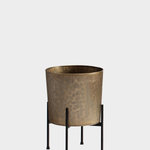

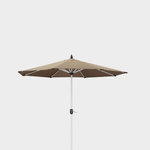










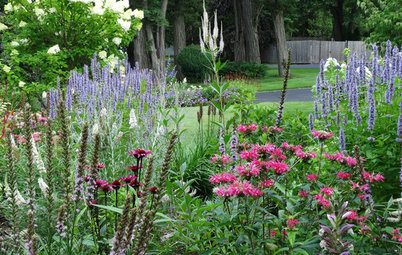
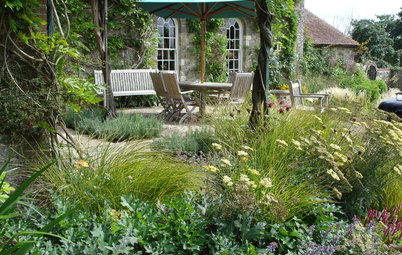

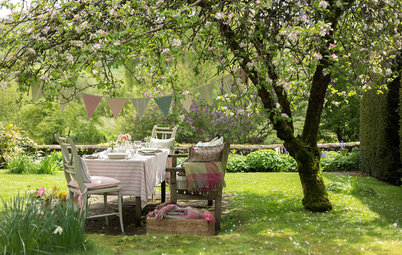
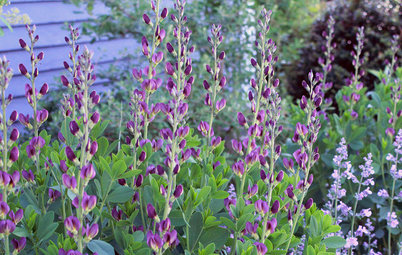
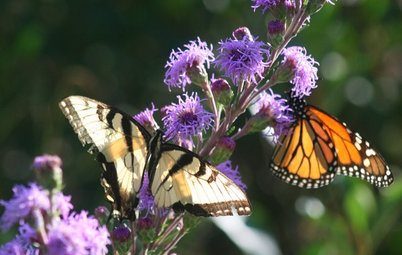
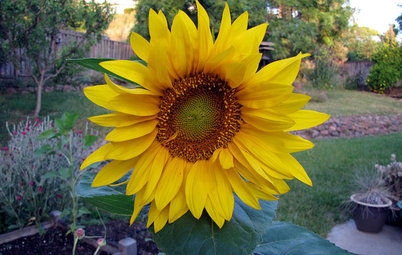
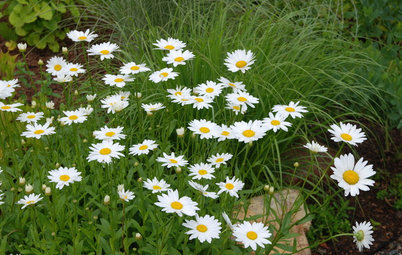

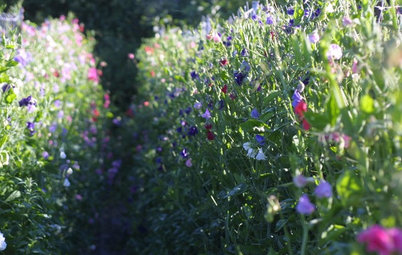
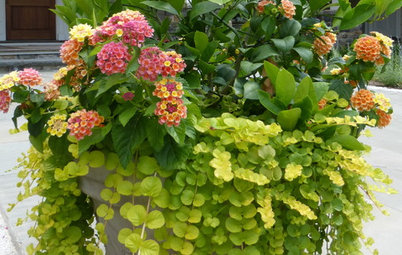
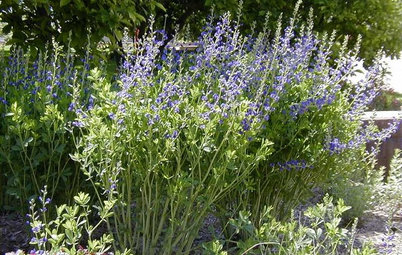
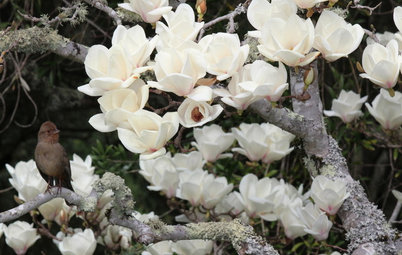
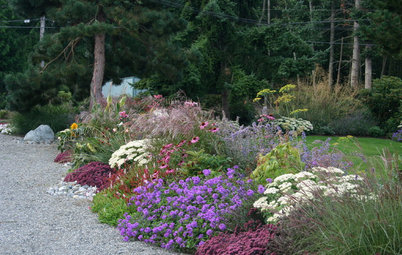
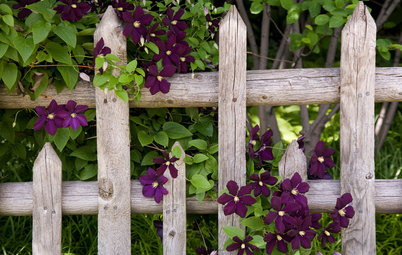






(Rudbeckia hirta)
Native to most of North America
Treasured for its sunshine-yellow flowers, black-eyed Susan shines brightly in cottage and perennial gardens. It’s an important food for butterflies and hummingbirds, tolerates dry conditions and can thrive in most kinds of soil.
Where it will grow: Hardy to minus 35 degrees Fahrenheit, or minus 37.2 degrees Celsius (USDA zones 3 to 7; find your zone)
Water requirement: Moderate; low once established
Light requirement: Full sun
Mature size: 2 to 3 feet tall and 1 foot to 2 feet wide
When to plant: Put nursery plants in the ground from late spring through midsummer; sow seeds in fall or spring.
Learn more about growing black-eyed Susan